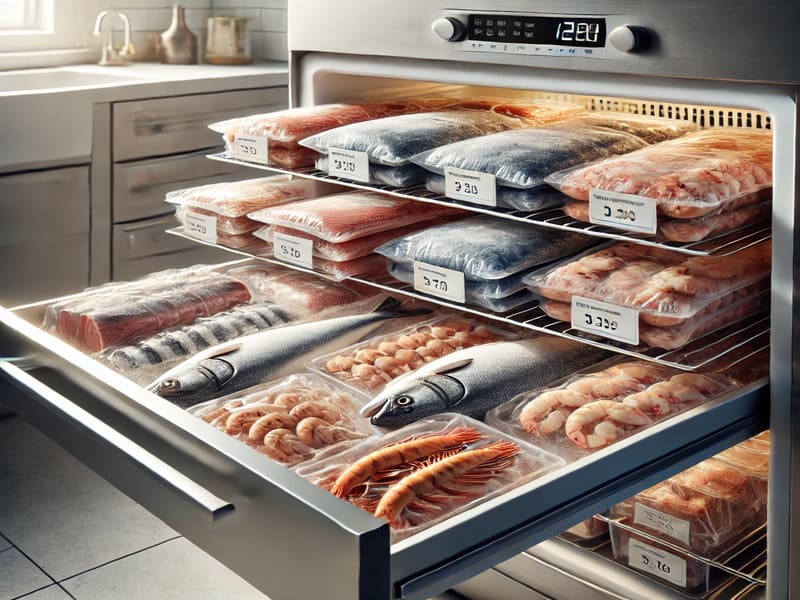Chamberlains of London – Frozen seafood has become a staple in households worldwide due to its convenience, affordability, and extended shelf life. Unlike fresh seafood, which requires immediate consumption, frozen options allow families to enjoy their favorite dishes without frequent trips to the market.
Freezing seafood at its peak freshness helps preserve its nutritional content, flavor, and texture. This process also reduces food waste, as frozen seafood can be stored for months without spoiling. Whether it’s shrimp, fish fillets, or squid, frozen seafood offers flexibility in meal planning and preparation, making it an ideal choice for busy lifestyles.
Key Steps for Storing Frozen Seafood Safely
Proper storage is essential to maximize the shelf life and quality of frozen seafood. Follow these steps to ensure your seafood remains safe and delicious:
- Check Packaging: Ensure the seafood is tightly sealed in vacuum-packed or air-tight containers. If the original packaging is damaged, transfer the seafood to a resealable freezer bag or wrap it tightly with plastic wrap and aluminum foil.
- Label and Date: Always label the packaging with the type of seafood and the date it was frozen. This helps track how long it has been stored and prevents consuming expired products.
- Set the Right Freezer Temperature: Keep your freezer at a consistent temperature of -18°C (0°F) or lower. Fluctuating temperatures can cause freezer burn and reduce the quality of the seafood.
- Organize the Freezer: Store seafood in the coldest part of the freezer, away from the door. This minimizes exposure to warm air when the freezer is opened.
By following these practices, frozen seafood can maintain its freshness and safety for up to 1.5 years, depending on the type and quality of the product.
“Also Read: How to Enjoy Seafood Without Raising Cholesterol Levels”
Common Mistakes to Avoid
While frozen seafood is convenient, improper handling can compromise its quality and safety. Avoid these common mistakes:
- Refreezing Thawed Seafood: Once seafood has been thawed, do not refreeze it. Refreezing can cause texture changes and increase the risk of bacterial growth.
- Overloading the Freezer: An overcrowded freezer can block airflow, making it difficult to maintain a consistent temperature. This can lead to uneven freezing and affect the quality of the seafood.
- Neglecting Freezer Burn: Freezer burn occurs when air reaches the seafood, causing dehydration and discoloration. While freezer-burned seafood is safe to eat, its texture and flavor may be compromised.
- Ignoring Expiration Dates: Even though frozen seafood lasts longer, it’s essential to consume it within the recommended storage period to enjoy its best quality.
Thawing Frozen Seafood the Right Way
Proper thawing is just as important as storage when it comes to maintaining the quality and safety of frozen seafood. Here are three safe methods to thaw seafood:
- Refrigerator Thawing: Place the seafood in the refrigerator overnight. This slow thawing process ensures even temperature and minimizes the risk of bacterial growth.
- Cold Water Thawing: Submerge the seafood in a sealed plastic bag in cold water. Change the water every 30 minutes to keep it cold and ensure the seafood thaws evenly.
- Microwave Thawing: If you’re short on time, use the defrost setting on your microwave. Cook the seafood immediately after thawing to avoid bacterial growth.
Avoid thawing seafood at room temperature, as this can lead to uneven thawing and increase the risk of foodborne illness. Always handle thawed seafood with clean hands and utensils.
“Also Read: Mongolian Vodka, A Traditional Drink with a Modern Twist”
Incorporating Frozen Seafood into Healthy Meals
Frozen seafood is versatile and can be used in a variety of recipes to create nutritious and flavorful meals. Here are some ideas:
- Stir-Fried Shrimp and Vegetables: Combine thawed shrimp with fresh vegetables, garlic, and soy sauce for a quick and healthy meal.
- Baked Salmon Fillets: Marinate salmon in lemon and herbs before baking it in the oven for a simple yet delicious dish.
- Seafood Pasta: Use thawed squid or mixed seafood in a creamy or tomato-based sauce for a hearty pasta dish.
- Seafood Soup: Add thawed seafood to a pot of broth, vegetables, and spices to create a comforting and nutritious soup.
By incorporating frozen seafood into your diet, you can enjoy the convenience of quick meal preparation without sacrificing quality or nutrition.
